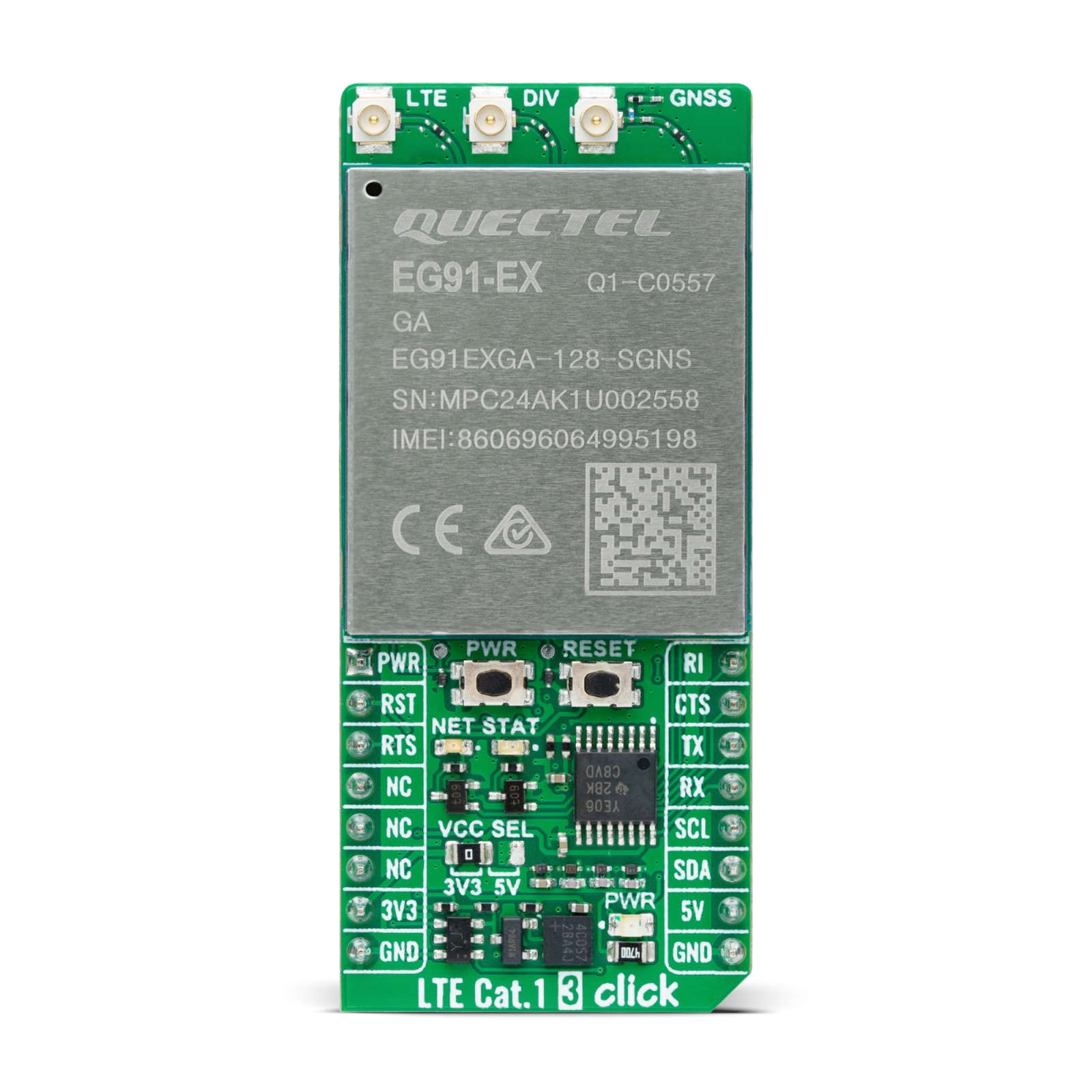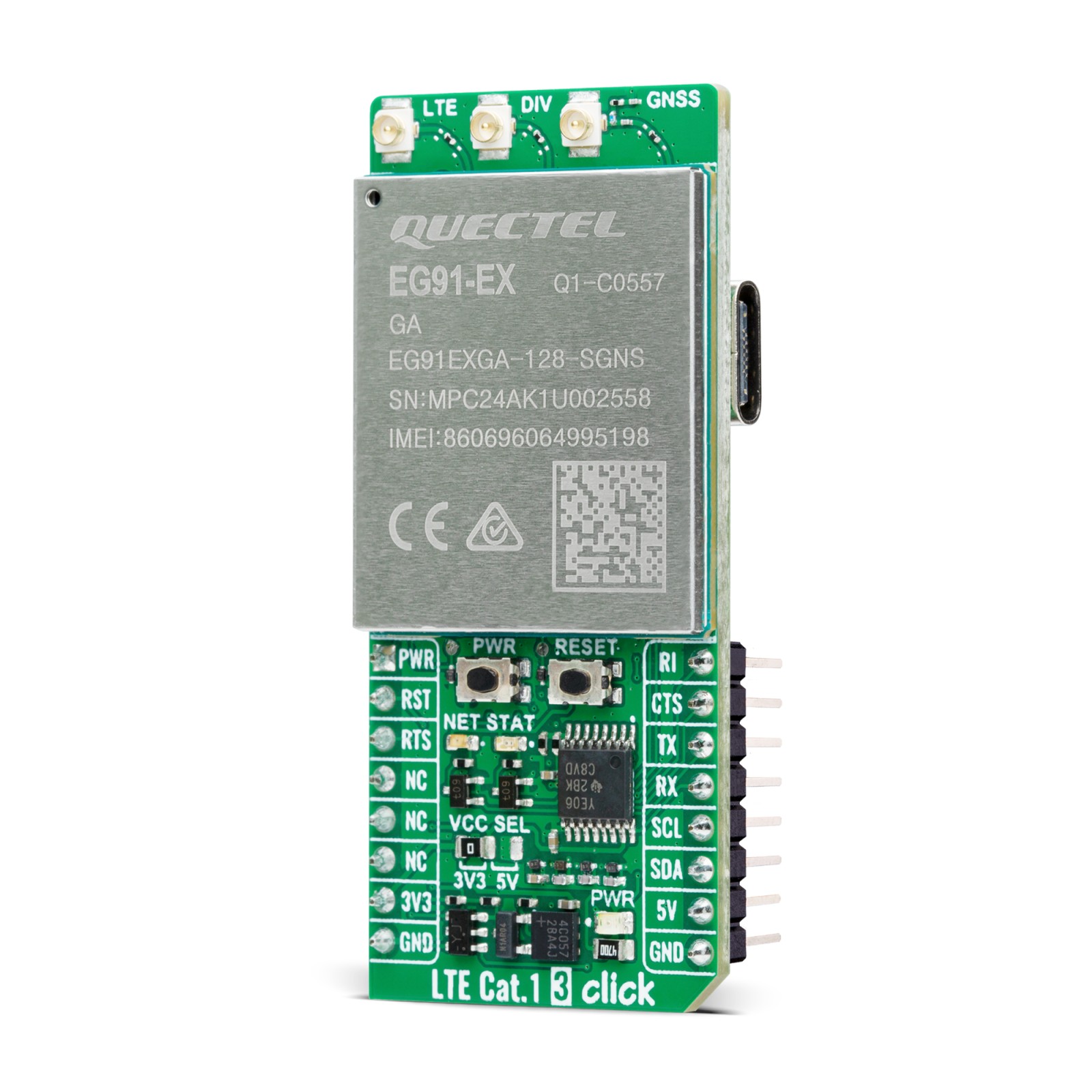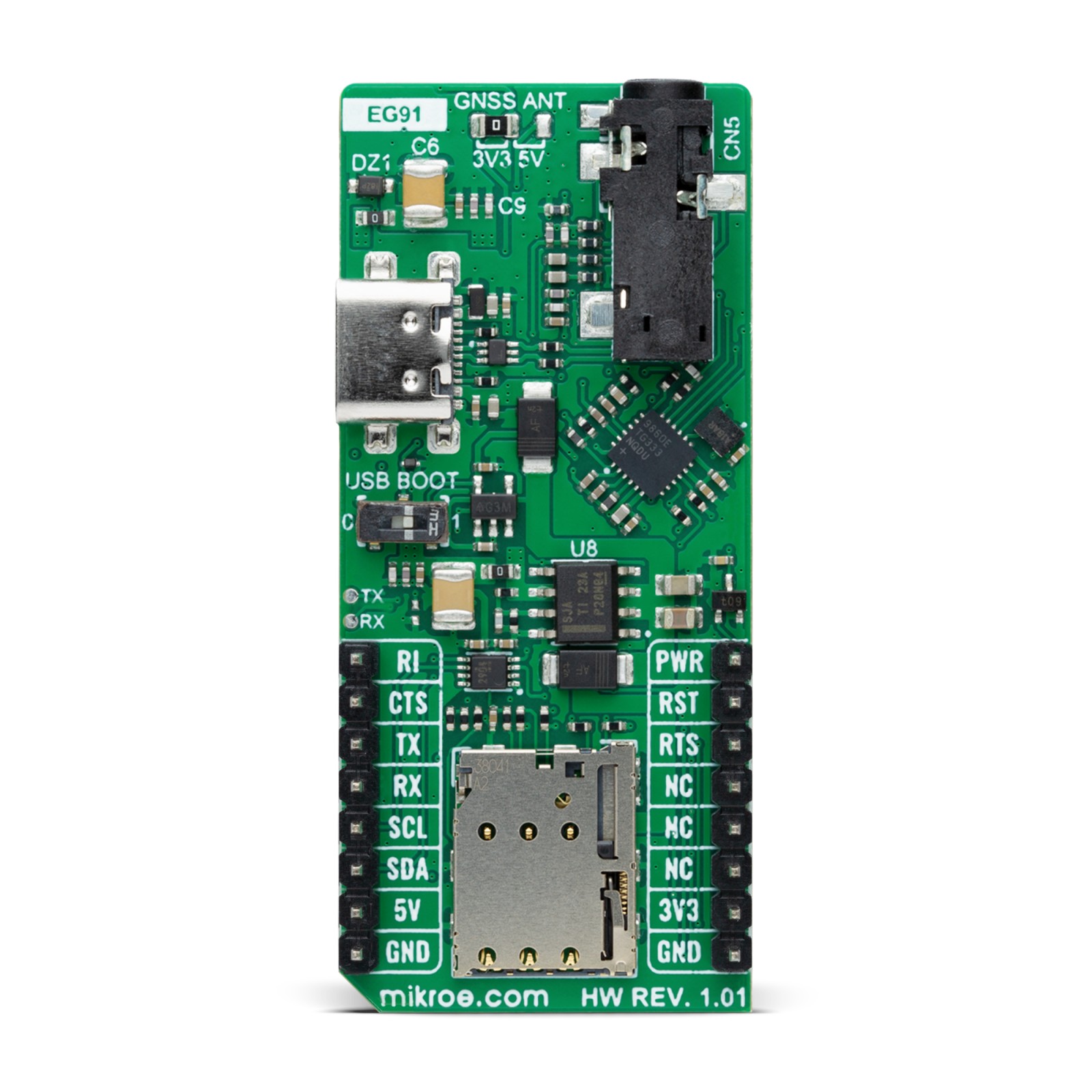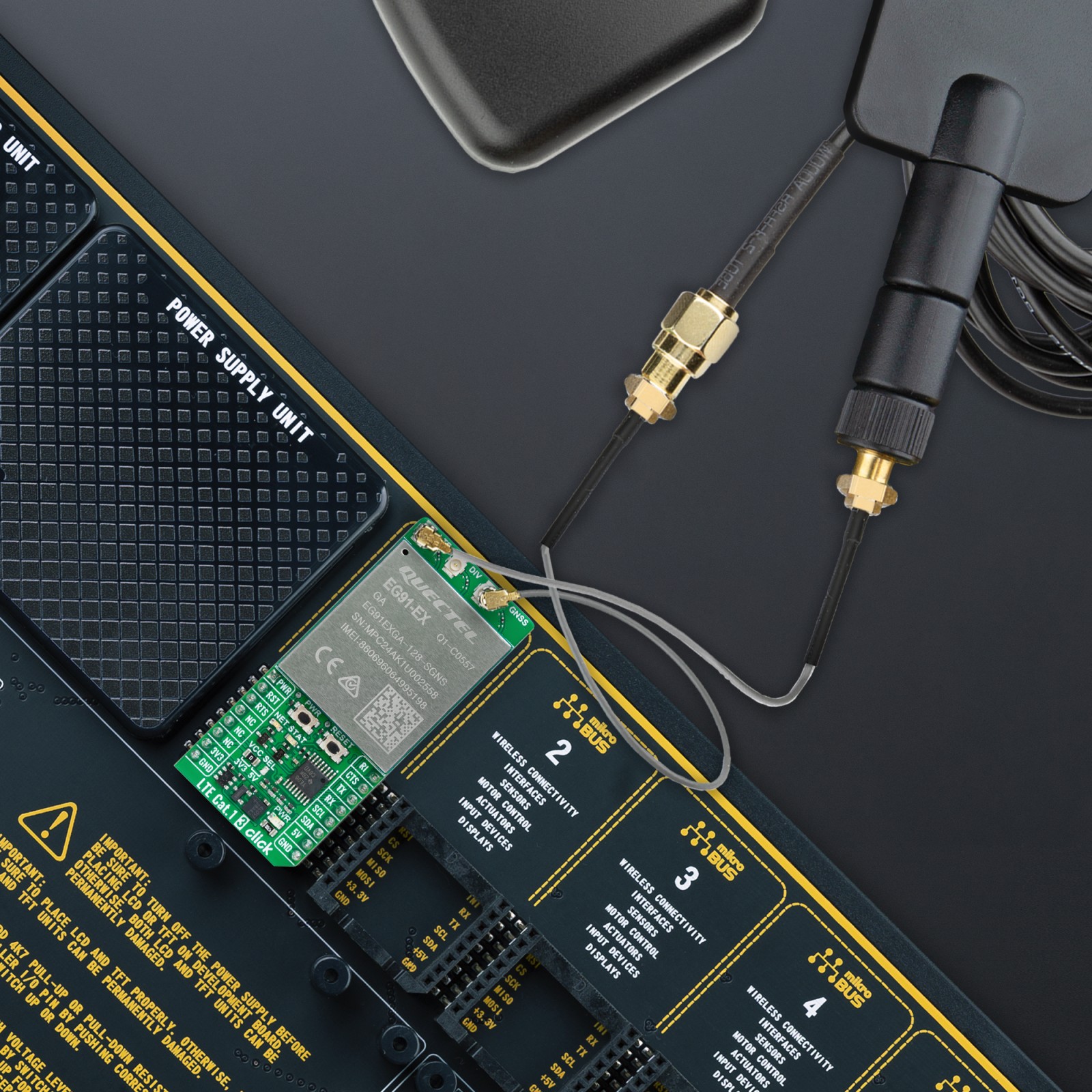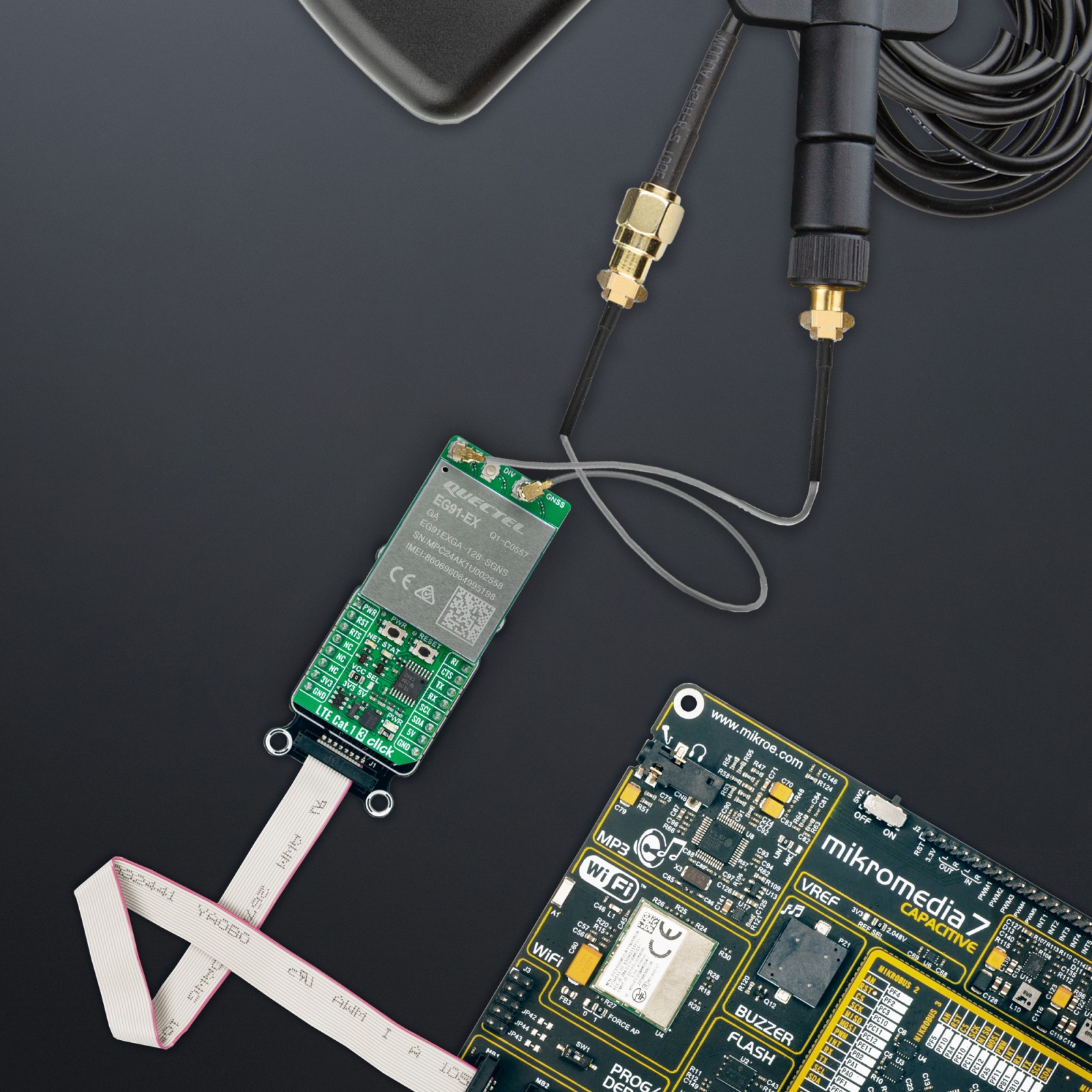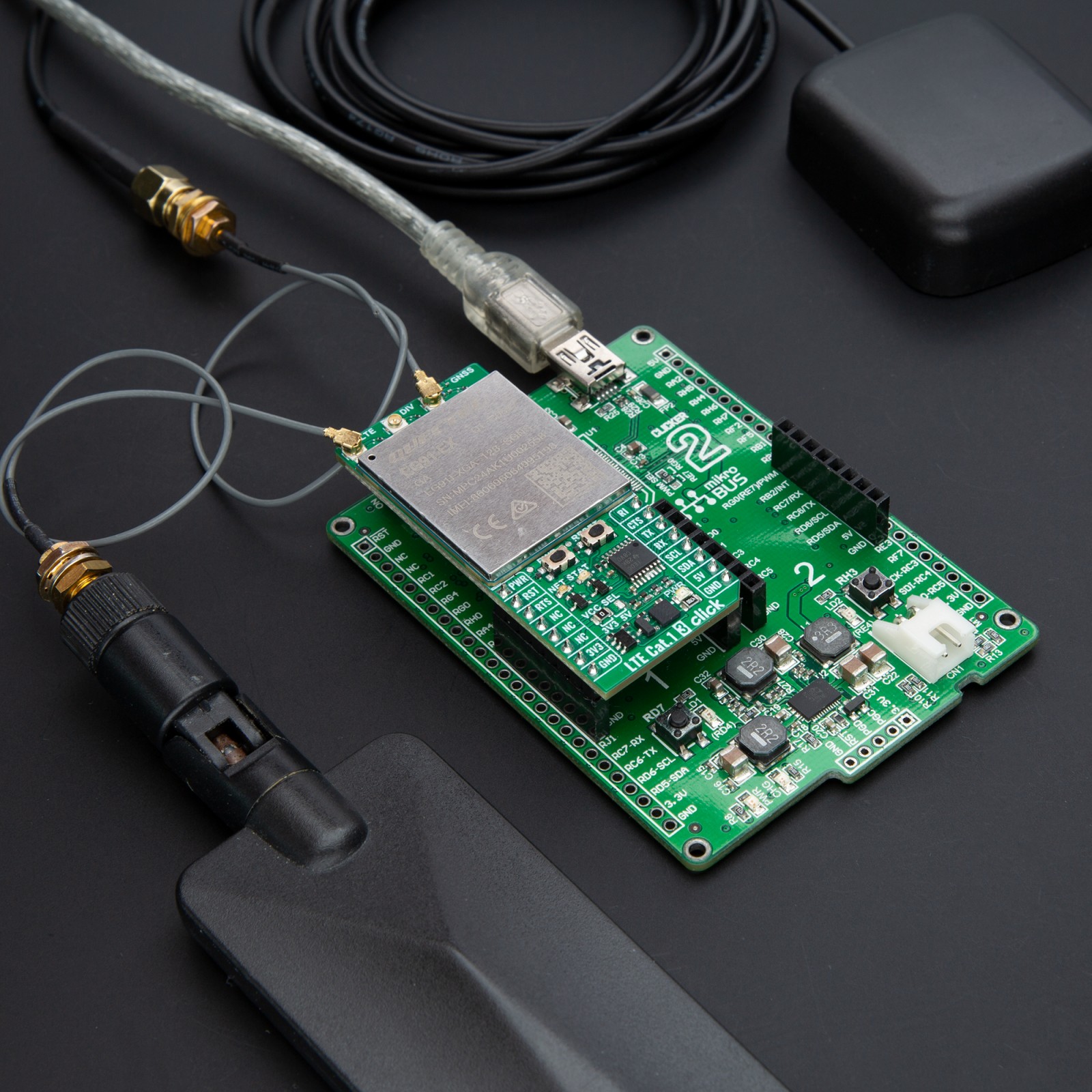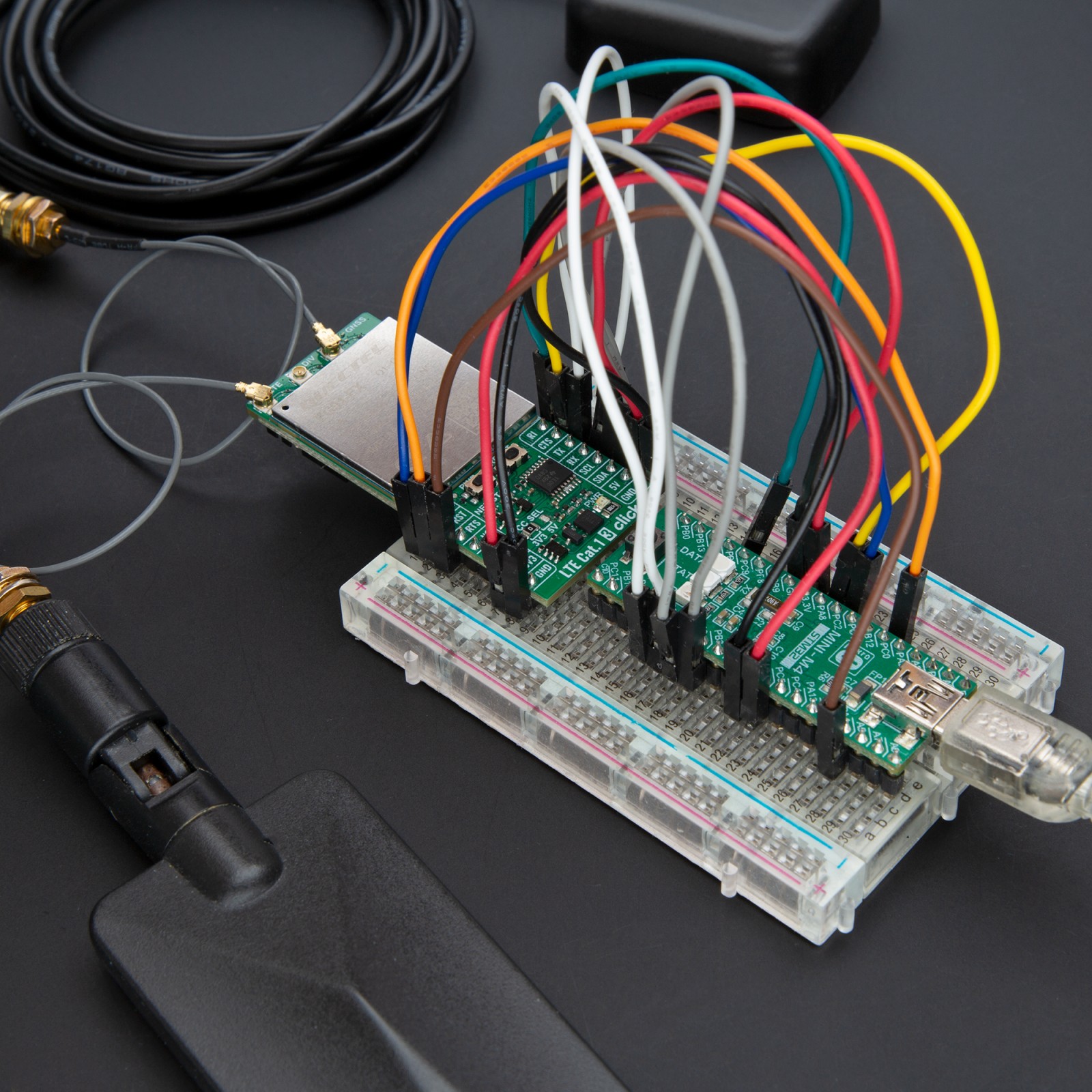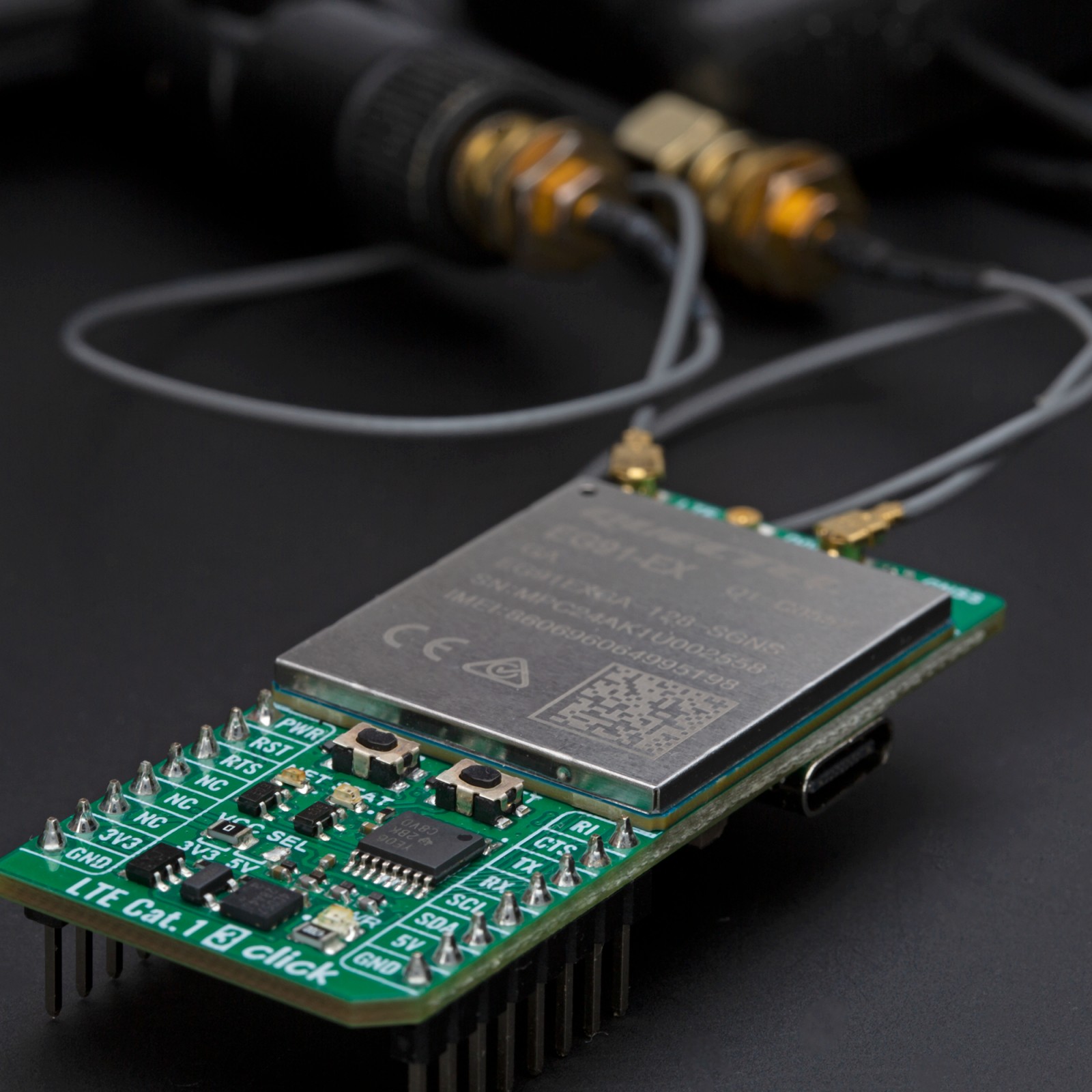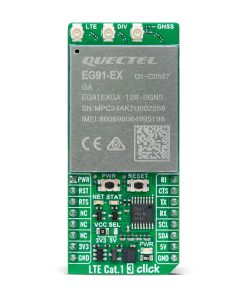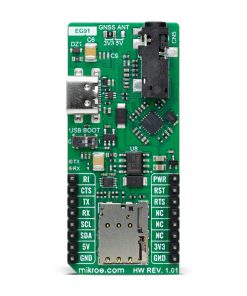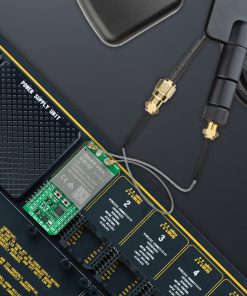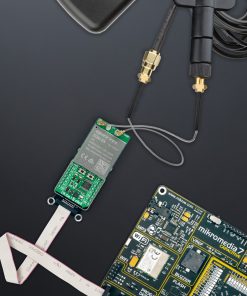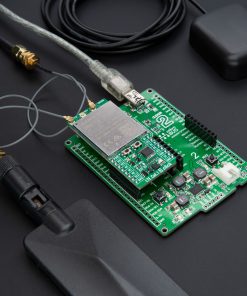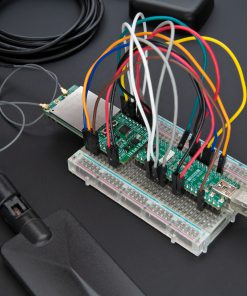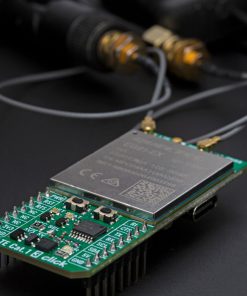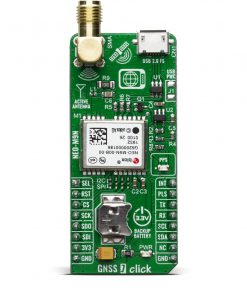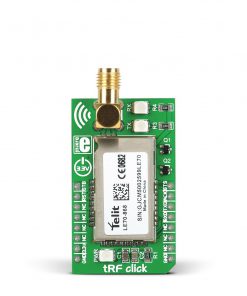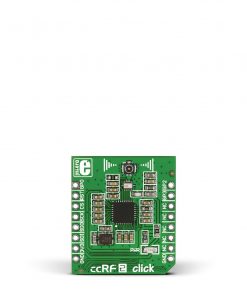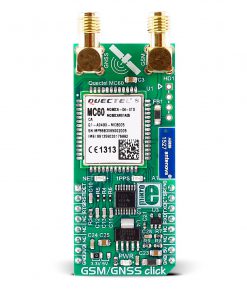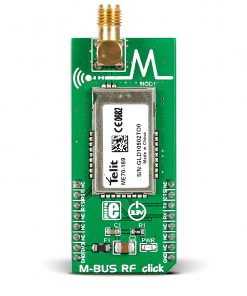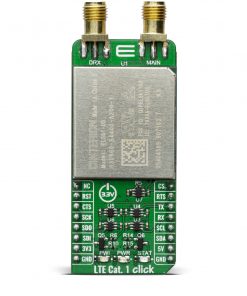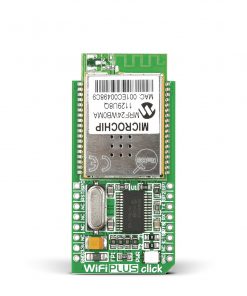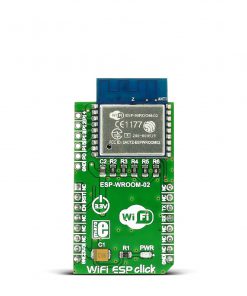LTE Cat.1 3 Click (for Europe)
R2,200.00 ex. VAT
LTE Cat.1 3 Click (for Europe) is a compact add-on board for reliable 4G wireless communication. This board features the EG91EXGA-128-SGNS, an LTE Cat 1 IoT module that meets the 3GPP Release 11 standard from Quectel. It supports multiple wireless standards, including LTE-FDD, WCDMA, and GSM, ensuring broad network compatibility. Key features include multi-band LTE support (B1/B3/B7/B8/B20/B28), RX diversity for bands B1 and B8, and multi-constellation GNSS (GPS, GLONASS, BeiDou/Compass, Galileo, QZSS). It also integrates a 16-bit mono audio codec for voice functionality with support for CTIA standard headphones. Additionally, it offers a USB Type C connector for power and data transfer, AT command communication, and firmware upgrades. This Click board™ is ideal for European M2M applications, such as automotive, smart metering, tracking systems, security, routers, and wireless POS.
LTE Cat.1 3 Click is fully compatible with the mikroBUS™ socket and can be used on any host system supporting the mikroBUS™ standard. It comes with the mikroSDK open-source libraries, offering unparalleled flexibility for evaluation and customization. What sets this Click board™ apart is the groundbreaking ClickID feature, enabling your host system to seamlessly and automatically detect and identify this add-on board.
Stock: Lead-time applicable.
| 5+ | R2,090.00 |
| 10+ | R1,980.00 |
| 15+ | R1,870.00 |
| 20+ | R1,799.60 |
How does it work?
LTE Cat.1 3 Click (for Europe) is based on the EG91EXGA-128-SGNS, an embedded 4G wireless communication module from Quectel with receive diversity. This module supports multiple wireless communication standards, including LTE-FDD, WCDMA, and GSM, providing reliable data connectivity across various networks. With the ability to also provide voice functionality (the telematics version supporting voice and data functions), this module is designed to meet customers’ specific needs. The LTE Cat.1 3 Click supports multiple LTE bands (B1/B3/B7/B8/B20/B28) and RX diversity for bands B1 and B8. Additionally, it offers multi-constellation GNSS support for GPS, GLONASS, BeiDou/Compass, Galileo, and QZSS. It is fully integrated with Internet service protocols such as TCP, UDP, and PPP, making it easy to use with extended AT commands. This Click board™ meets almost all requirements for M2M applications such as automotive, smart metering, tracking systems, security, routers, wireless POS, and many more.

Communication between the EG91EXGA-128-SGNS and the host MCU is made through a UART interface, using standard UART RX and TX pins and hardware flow control pins (CTS/RTS/RI – Clear to Send/Ready to Send/Ring Indicator) for efficient data transfer. The module defaults to a communication speed of 115200bps, allowing for seamless data exchange over AT commands. Notably, this telematics version of the module also features an audio interface, which can be accessed via the I2C interface.
The LTE Cat.1 3 Click audio interface operates through the MAX9860, a 16-bit mono audio voice codec configurable via the I2C interface. This setup works with a jack on the back of the board designed for CTIA standard headphones, which are commonly used in modern smartphones and feature a combined audio and microphone connector. This standard ensures compatibility with a wide range of headphones and headsets. Additionally, the audio interface supports advanced features such as echo cancellation and noise suppression, enhancing the clarity and quality of voice communications.
The LTE Cat.1 3 Click also includes a USB Type C connector for both power and data transfer, compliant with the USB 2.0 specification (slave only). This interface supports data transfer rates of up to 480Mbps, facilitating AT command communication, data transmission, GNSS NMEA sentence output, software debugging, firmware upgrades, and voice over USB. The board features a USB FW upgrade switch labeled USB BOOT to manage firmware upgrades. This switch has positions 0 for normal operation and 1 for firmware upgrades over USB, ensuring a straightforward upgrade process.
In addition, this Click board™ includes several additional functionalities that enhance its usability and control. The PWR button allows users to easily power the module on or off, while the RESET button provides a quick way to reset the module. These functions can also be controlled digitally via the mikroBUS™ pins PWR and RST, offering greater flexibility. Moreover, these controls have dedicated test points for easier debugging and testing. The board also features two visual indicators to provide real-time status updates. The red NET LED offers feedback on network activity: it flickers slowly when searching for a network, flickers quickly during data transfer, and remains steadily on during voice calls. The yellow STAT LED indicates the module’s power status, which stays off when the module is off and turns on when the module is powered on. The board also includes DBG TX/RX interface test points for debug UART communication, simplifying the development and troubleshooting process.
The board features three u.Fl connectors for GNSS, LTE, and LTE/WCDMA receive the diversity antenna that MIKROE offers, the LTE Flat Rotation Antenna and Active GPS Antenna combined with an IPEX-SMA cable for flexible and efficient connectivity options. In addition, the user can easily choose the power supply of the GNSS antenna by choosing between 3.3V and 5V on the GNSS ANT jumper. Additionally, the board is equipped with a micro SIM card holder that supports both 1.8V and 3.0V uSIM cards, ensuring compatibility with a wide range of cellular networks and allowing users to select the most appropriate service provider for their particular use case.
This Click board™ can operate with both 3.3V and 5V logic voltage levels selected via the VCC SEL jumper. Since the EG91-EX module operates at 3.8V, logic-level translators, the TXB0106 and PCA9306, are also used for proper operation and an accurate signal-level translation. This way, both 3.3V and 5V capable MCUs can use the communication lines properly. Also, this Click board™ comes equipped with a library containing easy-to-use functions and an example code that can be used as a reference for further development.
Specifications
Type
GSM/LTE
Applications
Ideal for European M2M applications such as automotive, smart metering, tracking system, security, router, wireless POS, and many more
On-board modules
EG91EXGA-128-SGNS – embedded 4G wireless communication module from Quectel
Key Features
Support of LTE-FDD, WCDMA, and GSM communication standards, multi-band European LTE support, RX diversity for bands B1 and B8, multi-constellation GNSS, 16-bit mono audio codec compatible with CTIA standard headphones, echo cancellation and noise suppression, USB Type C connector for power and data transfer, software debugging, firmware upgrades, UART communication, visual status indicators, several test points, micro SIM card holder, and more
Interface
I2C,UART
Feature
ClickID
Compatibility
mikroBUS™
Click board size
L (57.15 x 25.4 mm)
Input Voltage
3.3V or 5V
Pinout diagram
This table shows how the pinout on LTE Cat.1 3 Click corresponds to the pinout on the mikroBUS™ socket (the latter shown in the two middle columns).
Onboard settings and indicators
| Label | Name | Default | Description |
|---|---|---|---|
| LD1 | PWR | – | Power LED Indicator |
| LD2 | NET | – | Network Activity Status LED Indicator |
| LD3 | STAT | – | Module Operational Status LED Indicator |
| JP1 | VCC SEL | Left | Logic Voltage Level Selection 3V3/5V: Left position 3V3, Right position 5V |
| JP2 | GNSS ANT | Left | GNSS Antenna Supply Selection 3V3/5V: Left position 3V3, Right position 5V |
| T1 | PWR | – | Module Power-ON Button |
| T2 | RESET | – | Module Reset Button |
| SW1 | USB BOOT | Right | USB FW Upgrade Switch 0/1: Left position 0, Right position 1 |
| TP1-TP2 | TX-RX | – | Debug UART Interface Test Points |
| TP3 | PWR | – | Module Power-ON Test Point |
| TP4 | RESET | – | Module Reset Test Point |
LTE Cat.1 3 Click electrical specifications
| Description | Min | Typ | Max | Unit |
|---|---|---|---|---|
| Supply Voltage | 3.3 | – | 5 | V |
| LTE Frequency Range | 700 | – | 2700 | MHz |
| GNSS Frequency Range | 1559 | – | 1609 | MHz |
| GNSS Sensitivity (Cold Start) | – | -146 | – | dBm |
| GNSS TTFF (Cold Start) | – | 34.6 | – | sec |
| GNSS Accuracy (Open Sky) | – | <2.5 | – | m |
Software Support
We provide a library for the LTE Cat.1 3 EX Click as well as a demo application (example), developed using MIKROE compilers. The demo can run on all the main MIKROE development boards.
Package can be downloaded/installed directly from NECTO Studio Package Manager (recommended), downloaded from our LibStock™ or found on MIKROE github account.
Library Description
This library contains API for LTE Cat.1 3 EX Click driver.
Key functions
-
ltecat13ex_write_registerThis function writes a data byte into the selected register address. -
ltecat13ex_max9860_cfgThis function is used to set basic config for MAX9860 of LTE Cat.1 3 EX click board. -
ltecat13ex_send_sms_pduThis function sends text message to a phone number in PDU mode.
Example Description
Application example shows device capability of connecting to the network and sending SMS, TCP/UDP messages, calling the selected number, or getting GNSS location using standard “AT” commands.
void application_task ( void )
{
switch ( example_state )
{
case LTECAT13EX_CONFIGURE_FOR_NETWORK:
{
if ( LTECAT13EX_OK == ltecat13ex_cfg_for_network( ) )
{
example_state = LTECAT13EX_WAIT_FOR_CONNECTION;
}
break;
}
case LTECAT13EX_WAIT_FOR_CONNECTION:
{
if ( LTECAT13EX_OK == ltecat13ex_check_connection( ) )
{
example_state = LTECAT13EX_CONFIGURE_FOR_EXAMPLE;
}
break;
}
case LTECAT13EX_CONFIGURE_FOR_EXAMPLE:
{
if ( LTECAT13EX_OK == ltecat13ex_cfg_for_example( ) )
{
example_state = LTECAT13EX_EXAMPLE;
}
break;
}
case LTECAT13EX_EXAMPLE:
{
ltecat13ex_example( );
break;
}
default:
{
log_error( &logger, " Example state." );
break;
}
}
}
The full application code, and ready to use projects can be installed directly from NECTO Studio Package Manager (recommended), downloaded from our LibStock™ or found on MIKROE github account.
Other MIKROE Libraries used in the example:
- MikroSDK.Board
- MikroSDK.Log
- Click.LTECat13EX
Additional notes and informations
Depending on the development board you are using, you may need USB UART click, USB UART 2 Click or RS232 Click to connect to your PC, for development systems with no UART to USB interface available on the board. UART terminal is available in all MIKROE compilers.
mikroSDK
This Click board™ is supported with mikroSDK – MIKROE Software Development Kit. To ensure proper operation of mikroSDK compliant Click board™ demo applications, mikroSDK should be downloaded from the LibStock and installed for the compiler you are using.
For more information about mikroSDK, visit the official page.
Resources
Downloads
| Weight | 26 g |
|---|---|
| Brand | MikroElektronika |

